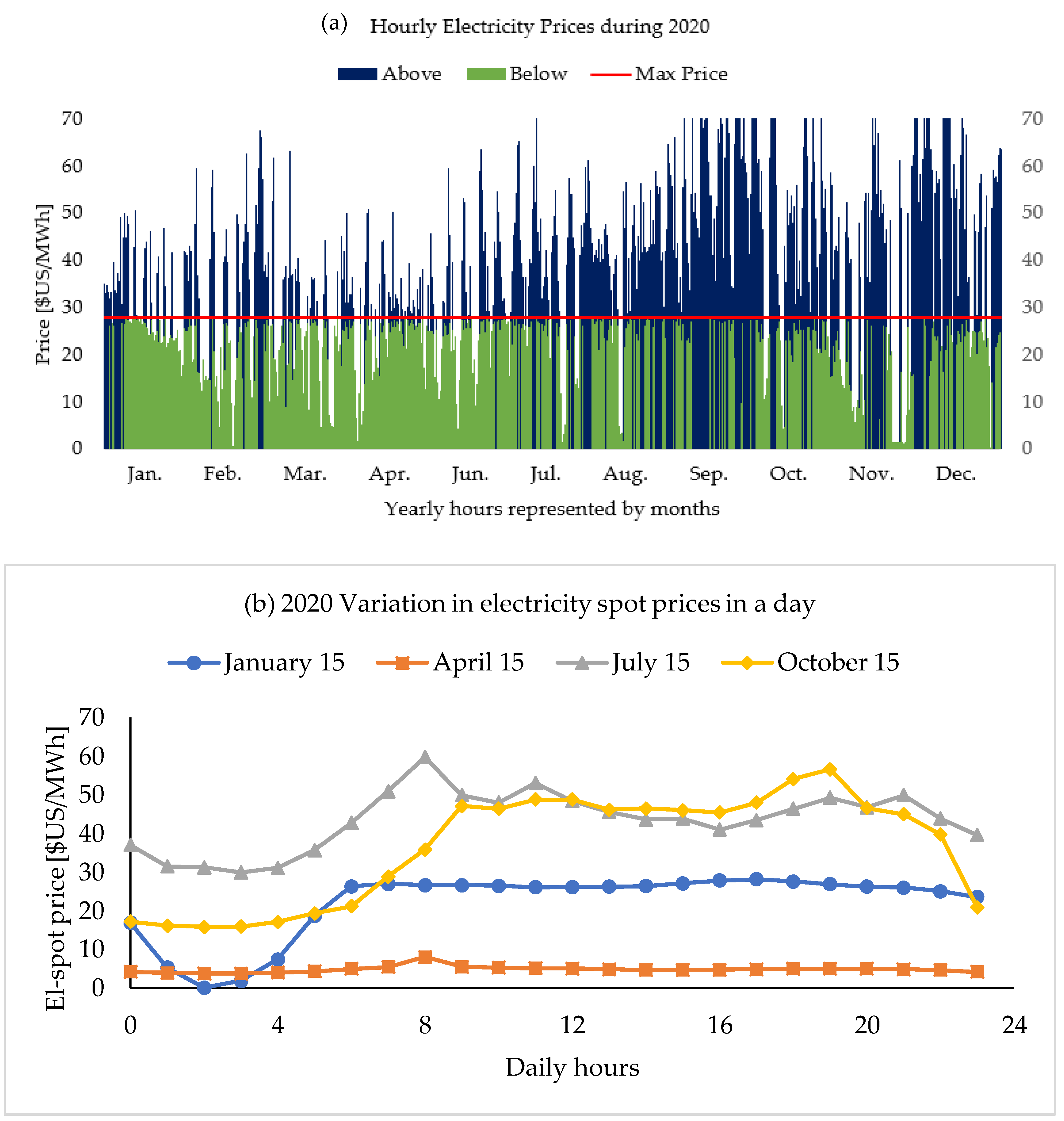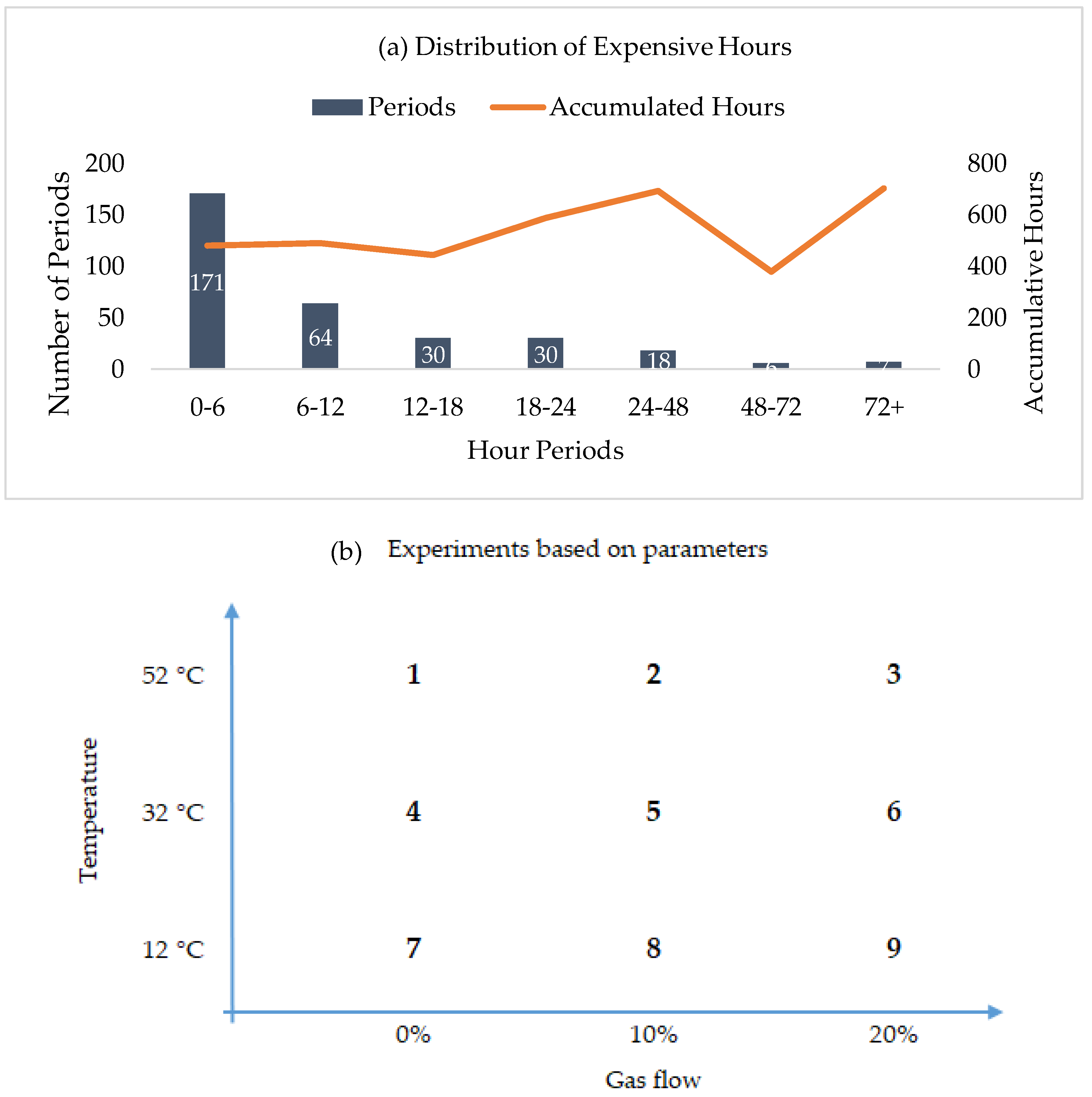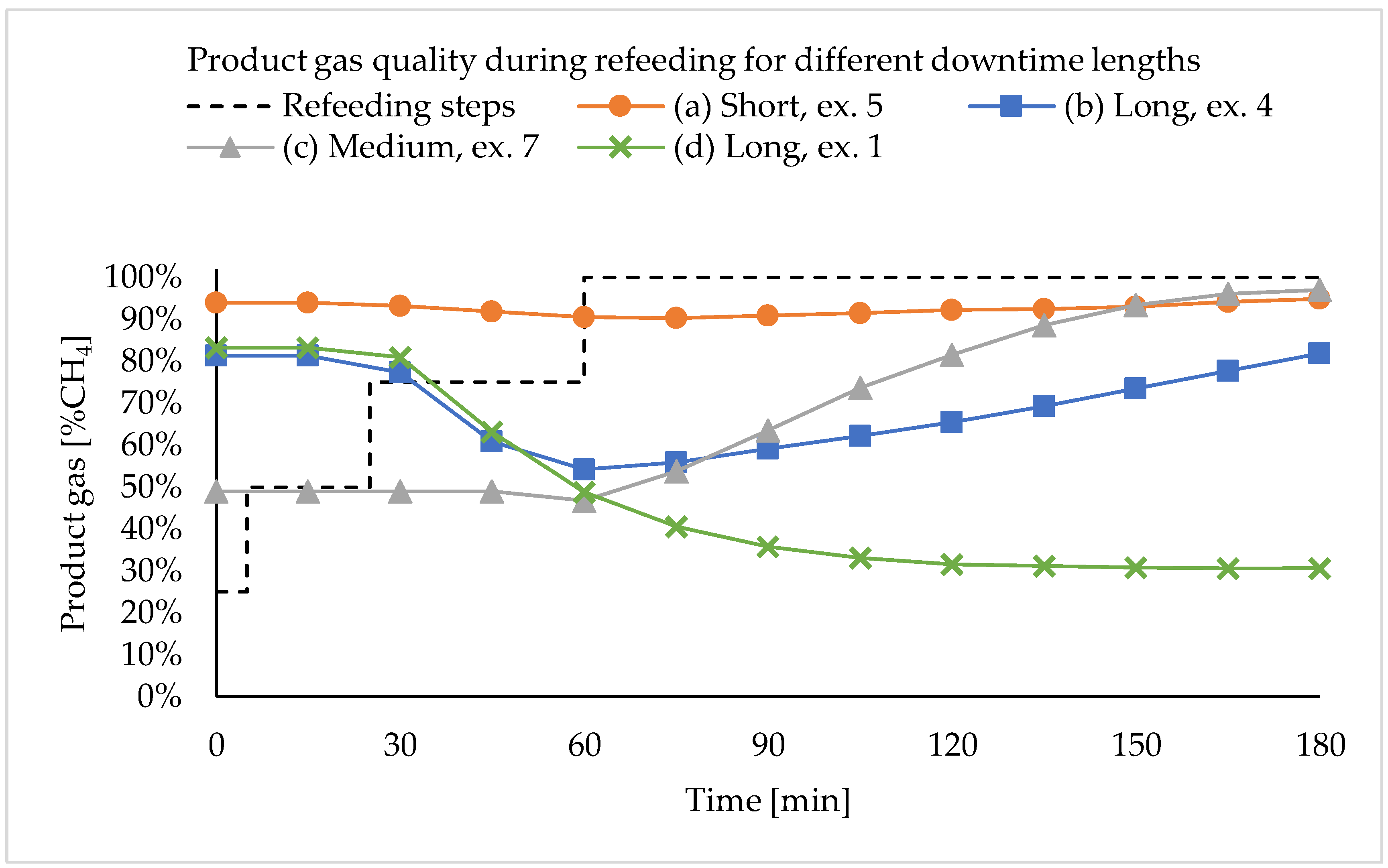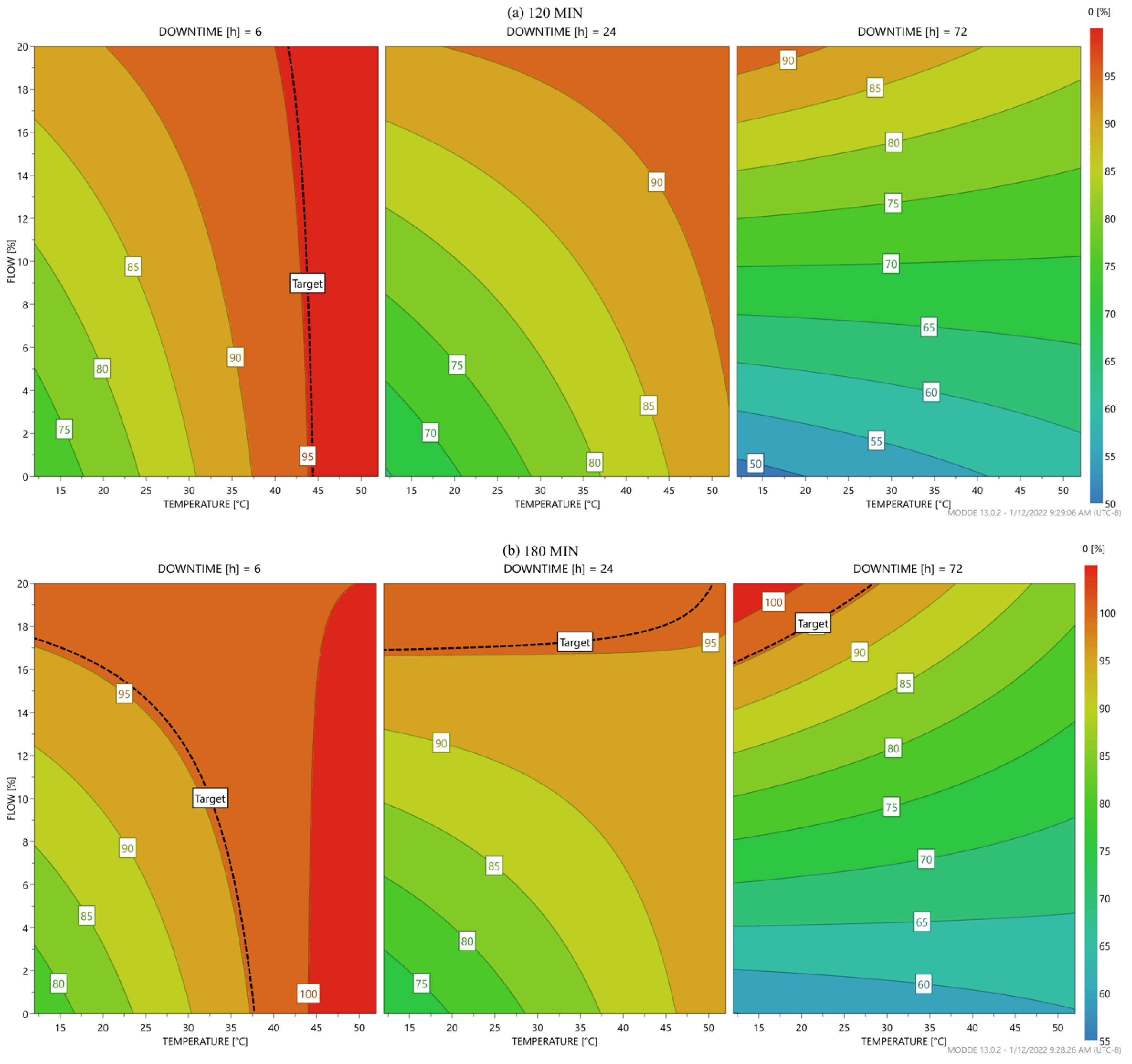Flexibility as the Key to Stability: Optimization of Temperature and Gas Feed during Downtime towards Effective Integration of Biomethanation in an Intermittent Energy System
Abstract
:1. Introduction
2. Materials and Methods
2.1. Reactor Configurations
2.2. Biotrickling Filter Operation
2.2.1. Inoculation of BTFs
2.2.2. Operational Conditions
2.2.3. Liquid Nutrient Supply
2.2.4. Gas and Liquid Analysis
2.3. Downtime Experimental Setup
2.3.1. Design of Experiment
2.3.2. Data Analysus Using MODDE®
3. Results and Discussion
3.1. Effect of Parameters on Downtime Lengths
3.1.1. Downtime of 6 h
3.1.2. Downtime of 24 h
3.1.3. Downtime of 72 h
3.2. Behaviour of BTFs during Downtime Experiments
3.2.1. Temperature Change during Downtime
3.2.2. Volatile Fatty Acids and pH
3.3. Product Gas Development after Initiation of Refeeding
3.3.1. Drop Tendency
3.3.2. Lag Phase Tendency
3.3.3. Decreasing Tendency
3.4. Estimation of Optimal Parameters for Variating Downtime Lengths
4. Perspective
5. Conclusions
Author Contributions
Funding
Acknowledgments
Conflicts of Interest
References
- European Commission. Energy from Renewable Sources. 2020. Available online: https://ec.europa.eu/eurostat/web/energy/data/shares (accessed on 14 October 2021).
- European Commission. 2030 Climate & Energy Framework. 2014. Available online: https://ec.europa.eu/clima/eu-action/climate-strategies-targets/2030-climate-energy-framework_en (accessed on 19 October 2021).
- European Commission. 2050 Long-Term Strategy. 2020. Available online: https://ec.europa.eu/clima/eu-action/climate-strategies-targets/2050-long-term-strategy_en (accessed on 19 October 2021).
- Lund, H.; Münster, E. Management of surplus electricity-production from a fluctuating renewable-energy source. Appl. Energy. 2003, 76, 65–74. [Google Scholar] [CrossRef]
- Sternberg, A.; Bardow, A. Power-to-What?—Environmental assessment of energy storage systems. Energy Environ. Sci. 2015, 8, 389–400. [Google Scholar] [CrossRef]
- Díaz-González, F.; Sumper, A.; Gomis-Bellmunt, O.; Villafafila-Robles, R. A review of energy storage technologies for wind power applications. Renew. Sustain. Energy Rev. 2012, 16, 2154–2171. [Google Scholar] [CrossRef]
- Thema, M.; Bauer, F.; Sterner, M. Power-to-Gas: Electrolysis and methanation status review. Renew. Sustain. Energy Rev. 2019, 112, 775–787. [Google Scholar] [CrossRef]
- Maroušek, J. Review: Nanoparticles can change (bio)hydrogen competitiveness. Fuel 2022, 328, 125318. [Google Scholar] [CrossRef]
- Götz, M.; Lefebvre, J.; Mörs, F.; McDaniel Koch, A.; Graf, F.; Bajohr, S.; Reimert, R.; Kolb, T. Renewable Power-to-Gas: A technological and economic review. Renew. Energy 2016, 85, 1371–1390. [Google Scholar] [CrossRef]
- Eurostat. Natural Gas Supply Statistics. 2020. Available online: https://ec.europa.eu/eurostat/statistics-explained/index.php?title=Natural_gas_supply_statistics (accessed on 19 October 2021).
- Rasi, S.; Veijanen, A.; Rintala, J. Trace compounds of biogas from different biogas production plants. Energy 2007, 32, 1375–1380. [Google Scholar] [CrossRef]
- Younas, M.; Kong, L.L.; Bashir, M.J.K.; Nadeem, H.; Shehzad, A.; Sethupathi, S. Recent Advancements, Fundamental Challenges, and Opportunities in Catalytic Methanation of CO2. Energy Fuels 2016, 30, 8815–8831. [Google Scholar] [CrossRef]
- Dannesboe, C.; Hansen, J.B.; Johannsen, I. Catalytic methanation of CO2 in biogas: Experimental results from a reactor at full scale. React. Chem. Eng. 2019, 5, 183–189. [Google Scholar] [CrossRef]
- Struis, R.P.; Schildhauer, T.J.; Czekaj, I.; Janousch, M.; Biollaz, S.M.; Ludwig, C. Sulphur poisoning of Ni catalysts in the SNG production from biomass: A TPO/XPS/XAS study. Appl. Catal. A Gen. 2009, 362, 121–128. [Google Scholar] [CrossRef]
- Burkhardt, M.; Jordan, I.; Heinrich, S.; Behrens, J.; Ziesche, A.; Busch, G. Long term and demand-oriented biocatalytic synthesis of highly concentrated methane in a trickle bed reactor. Appl. Energy 2019, 240, 818–826. [Google Scholar] [CrossRef]
- Nord Pool. Historical Market Data|Nord Pool. 2021. Available online: https://www.nordpoolgroup.com/historical-market-data (accessed on 15 November 2021).
- Matthischke, S.; Roensch, S.; Güttel, R. Start-up time and load range for the methanation of carbon dioxide in a fixed-bed recycle reactor. Ind. Eng. Chem. Res. 2018, 57, 6391–6400. [Google Scholar] [CrossRef]
- Strübing, D.; Moeller, A.B.; Mößnang, B.; Lebuhn, M.; Drewes, J.E.; Koch, K. Anaerobic thermophilic trickle bed reactor as a promising technology for flexible and demand-oriented H2/CO2 biomethanation. Appl. Energy 2018, 232, 543–554. [Google Scholar] [CrossRef]
- Strübing, D.; Moeller, A.B.; Mößnang, B.; Lebuhn, M.; Drewes, J.E.; Koch, K. Load change capability of an anaerobic thermophilic trickle bed reactor for dynamic H2/CO2 biomethanation. Bioresour. Technol. 2019, 289, 121735. [Google Scholar] [CrossRef]
- Logroño, W.; Popp, D.; Nikolausz, M.; Kluge, P.; Harms, H.; Kleinsteuber, S. Microbial communities in flexible biomethanation of hydrogen are functionally resilient upon starvation. Front. Microbiol. 2021, 12, 619632. [Google Scholar] [CrossRef] [PubMed]
- Nan, L.B.; Trably, E.; Santa-Catalina, G.; Bernet, N.; Delgenes, J.-P.; Escudie, R. Microbial community redundance in biomethanation systems lead to faster recovery of methane production rates after starvation. Sci. Total Environ. 2022, 804, 150073. [Google Scholar] [CrossRef]
- Bekendtgørelse Om Gaskvalitet, (n.d.). Available online: https://www.retsinformation.dk/eli/lta/2018/230 (accessed on 10 January 2022).
- Jønson, B.D.; Sieborg, M.U.; Ashraf, M.T.; Yde, L.; Shin, J.; Shin, S.G.; Triolo, J.M. Direct inoculation of a biotrickling filter for hydrogenotrophic methanogenesis. Bioresour. Technol. 2020, 318, 124098. [Google Scholar] [CrossRef]
- Ashraf, M.T.; Yde, L.; Triolo, J.M.; Wenzel, H. Optimizing the dosing and trickling of nutrient media for thermophilic biomethanation in a biotrickling filter. Biochem. Eng. J. 2021, 176, 108220. [Google Scholar] [CrossRef]
- Angelidaki, I.; Alves, M.M.; Bolzonella, D.; Borzacconi, L.; Campos, J.L.; Guwy, A.J.; Kalyuzhnyi, S.; Jenicek, P.; Van Lier, J.B. Defining the biomethane potential (BMP) of solid organic wastes and energy crops: A proposed protocol for batch assays. Water Sci. Technol. 2009, 59, 927–934. [Google Scholar] [CrossRef]
- Sieborg, M.U.; Jensen, M.B.; Jensen, B.; Kofoed, M.V.W. Effect of minimizing carrier irrigation on H2 conversion in trickle bed reactors during ex situ biomethanation. Bioresour. Technol. Rep. 2021, 16, 100876. [Google Scholar] [CrossRef]
- Ashraf, M.T.; Sieborg, M.U.; Yde, L.; Rhee, C.; Shin, S.G.; Triolo, J.M. Biomethanation in a thermophilic biotrickling filter—pH control and lessons from long-term operation. Bioresour. Technol. Rep. 2020, 11, 100525. [Google Scholar] [CrossRef]
- Sieborg, M.U.; Jønson, B.D.; Ashraf, M.T.; Yde, L.; Triolo, J.M. Biomethanation in a thermophilic biotrickling filter using cattle manure as nutrient media. Bioresour. Technol. Rep. 2020, 9, 100391. [Google Scholar] [CrossRef]
- Tsapekos, P.; Treu, L.; Campanaro, S.; Centurion, V.B.; Zhu, X.; Peprah, M.; Zhang, Z.; Kougias, P.G.; Angelidaki, I. Pilot-scale biomethanation in a trickle bed reactor: Process performance and microbiome functional reconstruction. Energy Convers. Manag. 2021, 244, 114491. [Google Scholar] [CrossRef]
- Savvas, S.; Donnelly, J.; Patterson, T.; Chong, Z.S.; Esteves, S.R. Methanogenic capacity and robustness of hydrogenotrophic cultures based on closed nutrient recycling via microbial catabolism: Impact of temperature and microbial attachment. Bioresour. Technol. 2018, 257, 164–171. [Google Scholar] [CrossRef]
- Ghofrani-Isfahani, P.; Tsapekos, P.; Peprah, M.; Kougias, P.; Zhu, X.; Kovalovszki, A.; Zervas, A.; Zha, X.; Jacobsen, C.S.; Angelidaki, I. Ex-situ biogas upgrading in thermophilic up-flow reactors: The effect of different gas diffusers and gas retention times. Bioresour. Technol. 2021, 340, 125694. [Google Scholar] [CrossRef]
- Thapa, A.; Park, J.-G.; Jun, H.-B. Enhanced ex-situ biomethanation of hydrogen and carbon dioxide in a trickling filter bed reactor. Biochem. Eng. J. 2022, 179, 108311. [Google Scholar] [CrossRef]
- Figeac, N.; Trably, E.; Bernet, N.; Delgenès, J.-P.; Escudié, R. Temperature and Inoculum Origin Influence the Performance of Ex-Situ Biological Hydrogen Methanation. Molecules 2020, 25, 5665. [Google Scholar] [CrossRef]
- Gray, N.D.; Sherry, A.; Larter, S.; Erdmann, M.; Leyris, J.; Liengen, T.; Beeder, J.; Head, I.M. Biogenic methane production in formation waters from a large gas field in the North Sea. Extremophiles 2009, 13, 511–519. [Google Scholar] [CrossRef]
- Bastidas-Oyanedel, J.-R.; Aceves-Lara, C.-A.; Ruiz-Filippi, G.; Steyer, J.-P. Thermodynamic Analysis of Energy Transfer in Acidogenic Cultures. Eng. Life Sci. 2008, 8, 487–498. [Google Scholar] [CrossRef]




| Downtime | Temperature | Flow | Time after Refeeding | CH4 | SD | Target | |
|---|---|---|---|---|---|---|---|
| [h] | [°C] | [%] | [min] | [%] | [%] | Quality | |
| Best performing | 6 | 52 | 0 | 60 | 98.4 | - * | Yes |
| parameters | 24 | 52 | 20 | 90 | 96.6 | ±0.7 | Yes |
| 72 | 12 | 20 | 180 | 91.0 | ±3.3 | No | |
| Least performing | 6 | 12 | 0 | 180 | 30.8 | - * | - |
| parameters | 24 | 12 | 10 | 180 | 90.3 | ±1.2 | - |
| 72 | 52 | 0 | 180 | 30.6 | ±3.6 | - |
Publisher’s Note: MDPI stays neutral with regard to jurisdictional claims in published maps and institutional affiliations. |
© 2022 by the authors. Licensee MDPI, Basel, Switzerland. This article is an open access article distributed under the terms and conditions of the Creative Commons Attribution (CC BY) license (https://creativecommons.org/licenses/by/4.0/).
Share and Cite
Jønson, B.D.; Mortensen, L.O.L.; Schmidt, J.E.; Jeppesen, M.; Bastidas-Oyanedel, J.-R. Flexibility as the Key to Stability: Optimization of Temperature and Gas Feed during Downtime towards Effective Integration of Biomethanation in an Intermittent Energy System. Energies 2022, 15, 5827. https://doi.org/10.3390/en15165827
Jønson BD, Mortensen LOL, Schmidt JE, Jeppesen M, Bastidas-Oyanedel J-R. Flexibility as the Key to Stability: Optimization of Temperature and Gas Feed during Downtime towards Effective Integration of Biomethanation in an Intermittent Energy System. Energies. 2022; 15(16):5827. https://doi.org/10.3390/en15165827
Chicago/Turabian StyleJønson, Brian Dahl, Lars Ole Lykke Mortensen, Jens Ejbye Schmidt, Martin Jeppesen, and Juan-Rodrigo Bastidas-Oyanedel. 2022. "Flexibility as the Key to Stability: Optimization of Temperature and Gas Feed during Downtime towards Effective Integration of Biomethanation in an Intermittent Energy System" Energies 15, no. 16: 5827. https://doi.org/10.3390/en15165827
APA StyleJønson, B. D., Mortensen, L. O. L., Schmidt, J. E., Jeppesen, M., & Bastidas-Oyanedel, J.-R. (2022). Flexibility as the Key to Stability: Optimization of Temperature and Gas Feed during Downtime towards Effective Integration of Biomethanation in an Intermittent Energy System. Energies, 15(16), 5827. https://doi.org/10.3390/en15165827








